ESP PONTIAC BONNEVILLE 1993 Owners Manual
[x] Cancel search | Manufacturer: PONTIAC, Model Year: 1993, Model line: BONNEVILLE, Model: PONTIAC BONNEVILLE 1993Pages: 322, PDF Size: 16.31 MB
Page 18 of 322
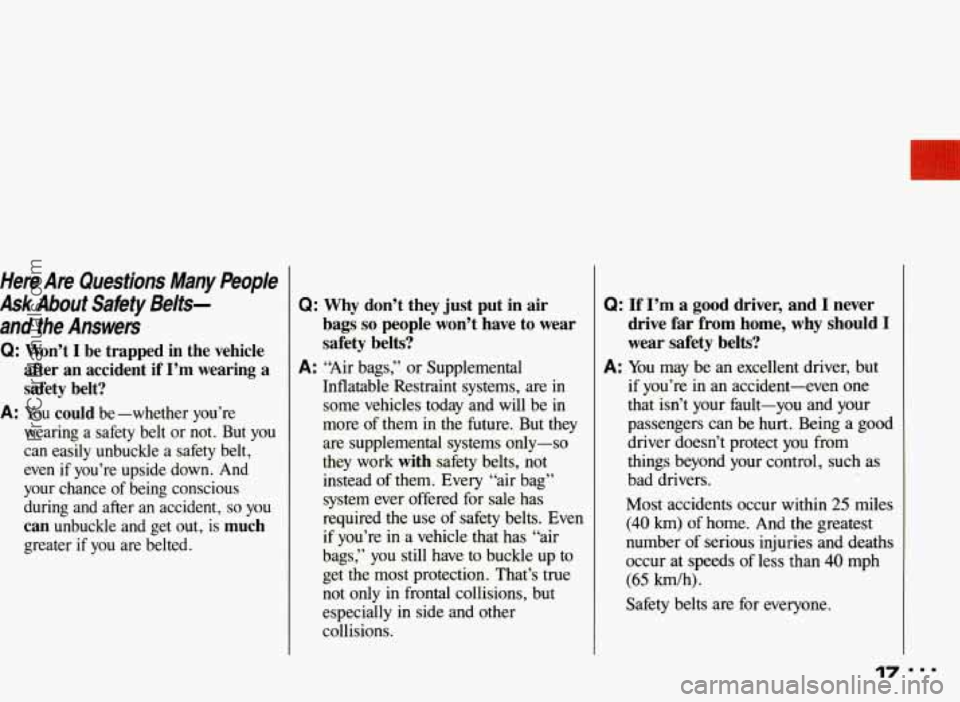
Here Are Questions Many People
Ask About Safety Belts-
and the Answers
Q: Won’t 1 be trapped in the vehicle
after an accident if I’m wearing a
safety belt?
wearing a safety belt or not. But you
can easily unbuckle a safety belt,
even if you’re upside down. And
your chance of being conscious
during and after an accident,
so you
can unbuckle and get out, is much
greater if you are belted.
A: You could be-whether you’re
Q: Why don’t they just put in air
bags
so people won’t have to wear
safety belts?
Inflatable Restraint systems, are in
some vehicles today and will be in
more of them in the future. But they
are supplemental systems
only-so
they work with safety belts, not
instead of them. Every “air bag’’
system ever offered for sale has
required the use
of safety belts. Even
if you’re
in a vehicle that has “air
bags,”
you still have to buckle up to
get the most protection. That’s true
not
only in frontal collisions, but
especially in side and other
collisions.
A: “Air bags,” or Supplemental Q:
If I’m a
good driver, and I never
drive far from home, why should I
wear safety belts?
if you’re in an accident-even one
that isn’t your fault-you and your
passengers can be hurt. Being a good
driver doesn’t protect you from
things beyond your control, such as
bad drivers.
Most accidents occur within
25 miles
(440 h) of home. And the greatest
number of serious injuries and deaths
occur at speeds of less than
40 mph
(65 km/h).
Safety belts are
for everyone.
A: You may be an excellent driver, but
17
ProCarManuals.com
Page 48 of 322
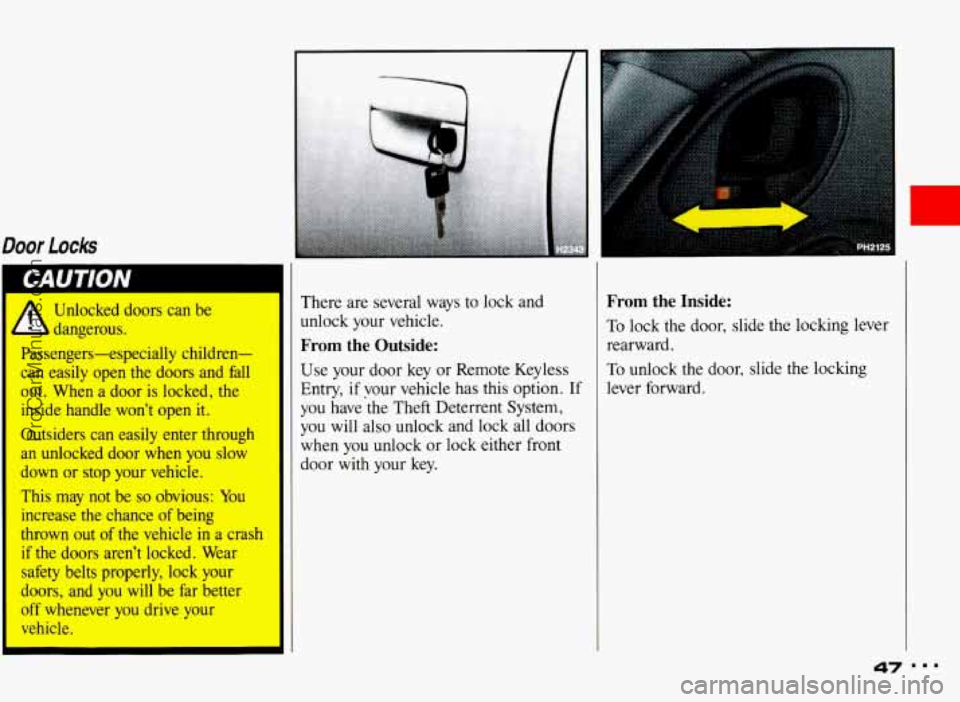
Door Locks
Unlocked doors can be
dangerous.
Passengers-especially children-
can easily open the doors and fall
out. When a door is locked, the
inside handle won't open it.
Outsiders can easily enter through
an unlocked door when you slow
down or stop your vehicle.
This may not be
so obvious: You
increase the chance
of being
thrown out
of the vehicle in a crash
if the doors aren't locked. Wear
safety belts properly, lock your
doors, and you will be far better
off whenever you drive your
vehicle. There
are several ways to lock and
unlock your vehicle.
From the Outside:
Use your door key or Remote Keyless
Entry, if vour vehicle has this option. If
you have the Theft Deterrent System,
you will also unlock and lock all doors
when you unlock
or lock either front
door with your key.
From the Inside:
To lock the door, slide the locking lever
rearward.
To unlock the door, slide the locking
lever forward.
47 ===
ProCarManuals.com
Page 52 of 322
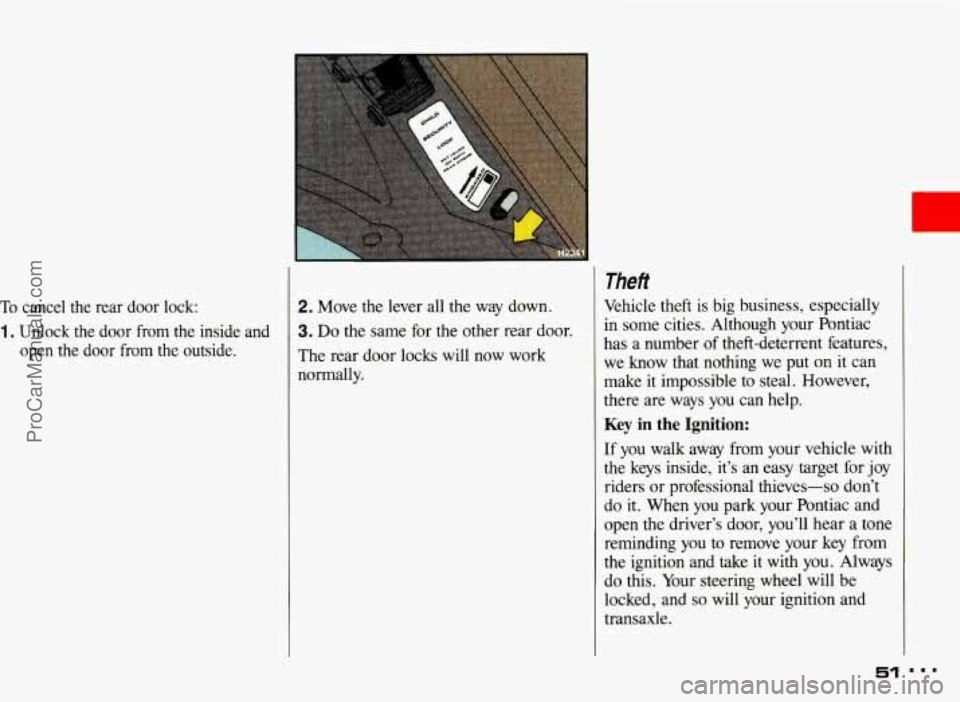
To cancel the rear door lock:
1. Unlock the door from the inside and
open the door from the outside.
2. Move the lever all the way down.
3. Do the same for the other rear door.
The rear door locks will now work
normally.
Theft
Vehicle theft is big business, especially
in some cities. Although your Pontiac
has a number
of theft-deterrent features,
we know that nothing we put
on it can
make it impossible to steal. However,
there are ways you can help.
Key in the Ignition:
If you walk away from your vehicle with
the keys inside, it’s an easy target for joy
riders or professional thieves-so don’t
do
it. When you park your Pontiac and
open the driver’s door, you’ll hear a tone
reminding you
to remove your key from
the ignition and take it with you. Always
do this. Your steering wheel will be
locked, and
so will your ignition and
transaxle.
51
ProCarManuals.com
Page 83 of 322
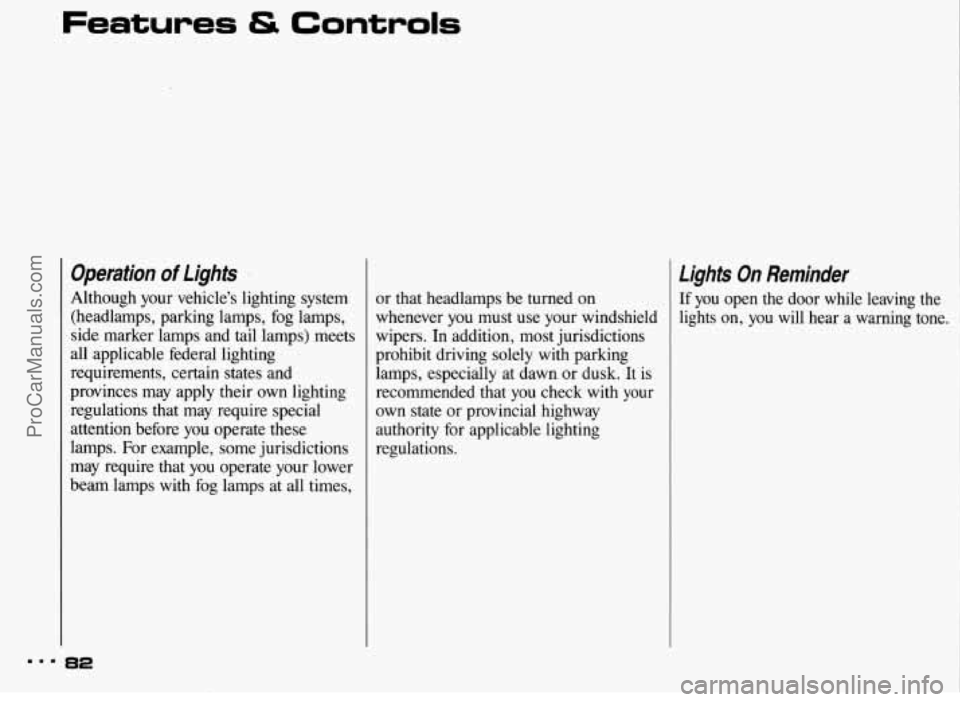
...
Features & Controls
Operation of lights '
Although your vehicle's lighting system (headlamps, parking lamps, fog lamps,
side marker lamps and tail lamps) meets
all applicable federal lighting
requirements, certain states and
provinces may apply their own lighting
regulations that may require special
attention before you operate these
lamps. For example, some jurisdictions
may require that you operate your lower
beam lamps with fog lamps at all times,
62
or that headlamps be turned on
whenever you must use your windshield wipers. In addition, most jurisdictions
prohibit driving solely with parking
lamps, especially at dawn or dusk. It is
recommended that you check with your
own state or provincial highway
authority for applicable lighting
regulations.
lights On Reminder
If you open the door while leaving the
lights on, you will hear a warning tone.
ProCarManuals.com
Page 141 of 322
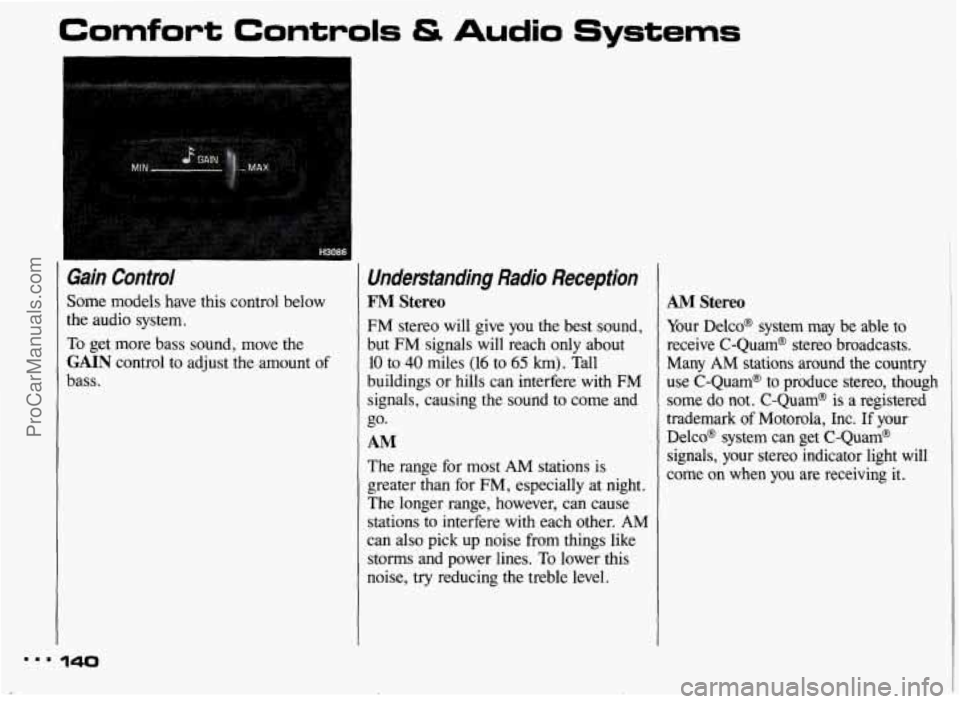
Comfort Controls & Audio Systems
Gain Control
Some models have this control below
the audio system.
To get more bass sound, move the
GAIN control to adjust the amount of
bass.
Understanding Radio Reception
FM Stereo
FM stereo will give you the best sound,
but FM signals will reach only about
10 to 40 miles (16 to 65 km). Tall
buildings or hills can interfere with
FM
signals, causing the sound to come and
go.
AM
The range for most AM stations is
greater than for FM, especially at night.
The longer range, however, can cause
stations to interfere with each other.
AM
can also pick up noise from things like
storms and power lines. To lower this
noise, try reducing the treble level.
AM Stereo
Your Delco@ system may be able to
receive C-Quam@ stereo broadcasts.
Many
AM stations around the country
use C-Quam@ to produce stereo, though some
do not. C-Quam@ is a registered
trademark of Motorola, Inc. If your
Delco@ system can get C-Quam@
signals, your stereo indicator light will
come on when you are receiving it.
' 140
ProCarManuals.com
Page 154 of 322
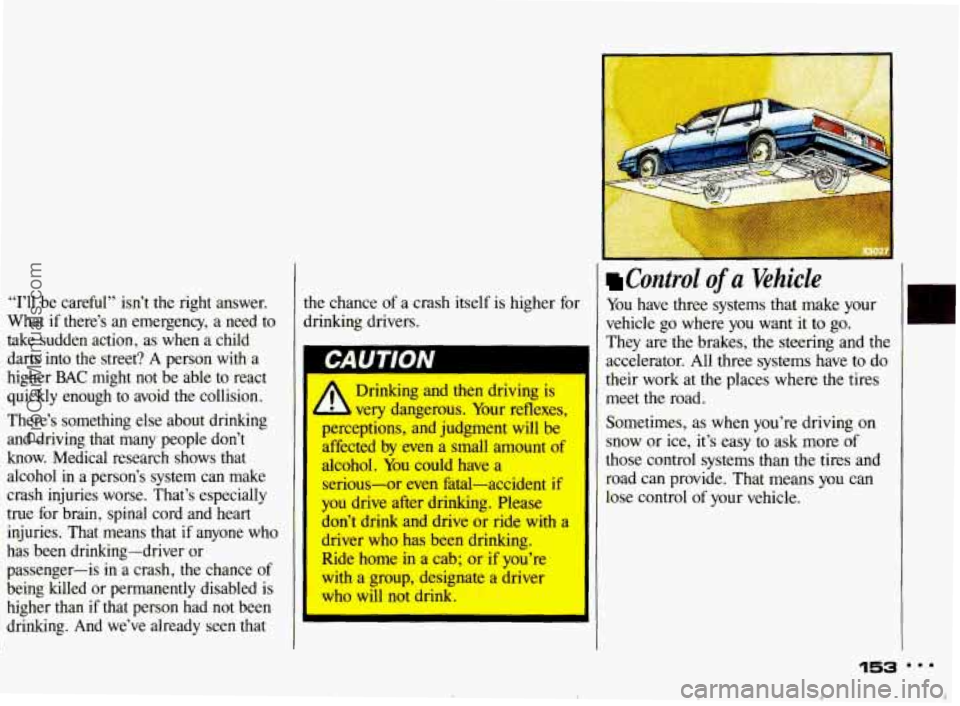
“I’ll be careful” isn’t the right answer.
What if there’s an emergency, a need
to
take sudden action, as when a child
darts into the street?
A person with a
higher
BAC might not be able to react
quickly enough to avoid
the collision.
There’s something else about drinking
and driving that many people don’t
know. Medical research shows that
alcohol
in a person’s system can make
crash injuries worse. That’s especially
true for brain, spinal cord and heart injuries. That means that if anyone who
has been drinking-driver or
passenger-is
in a crash, the chance of
being killed or permanently disabled is
higher than if that person had not been
drinking. And we’ve already seen that the
chance of a crash itself is higher for
drinking drivers.
’ Drinking and then driving is
very dangerous. Your reflexes,
perceptions, and judgment will be
affected by even a small amount
of
alcohol. You could have a
serious-or even fatal-accident
if
you drive after drinking. Please
don’t drink and drive or ride with a
driver who has been drinking.
Ride home in a cab; or
if you’re
with a group, designate a driver
who will not drink.
Control of a Vehicle
You have three systems that make your
vehicle
go where you want it to go.
They are the brakes, the steering and the
accelerator. All three systems have
to do
their work at the places where the tires
meet the road.
Sometimes, as when you’re driving
on
snow or ice, it’s easy to ask more of
those control systems than the tires and
road can provide. That means you can
lose control
of your vehicle.
3 ProCarManuals.com
Page 158 of 322
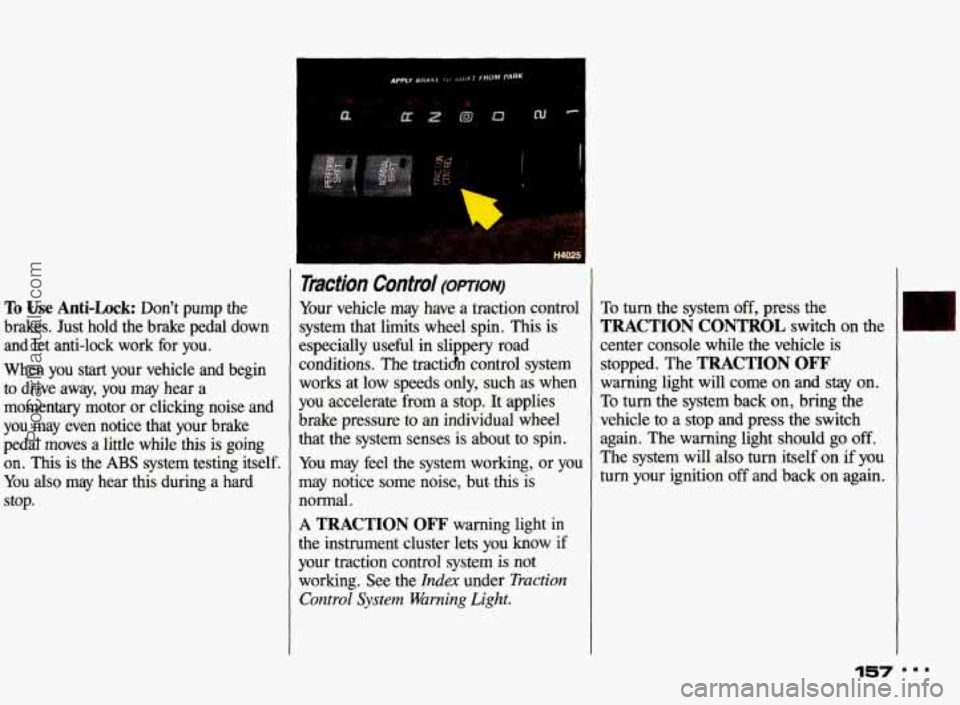
To Use Anti-Lock: Don't pump the
brakes. Just hold the brake pedal down
and let anti-lock work for you.
When you
start your vehicle and begin
to drive away, you may hear a
momentary motor
or clicking noise and
you may even notice that your brake
pedal
moves a little while this is going
on. This is the
ABS system testing itself.
You also may hear this during a hard
stop.
I--
Tiction Control (omm)
Your vehicle may have a traction control
system that limits wheel spin. This is
especially useful in slippery road
conditions. The tractidn control system
works at low speeds only, such as when
you accelerate from a stop. It applies
brake pressure
to an individual wheel
that the system senses is about to spin.
You may feel the system working, or you
may notice some noise, but. this is
normal.
A TRACTION OFF warning light in
the instrument cluster lets you know if
your traction control system
is not
working. See the
Index under Traction
Control
System Warning Light.
To turn the system off, press the
TRACTION CONTROL switch on the
center console while the vehicle is
stopped. The
TRACTION OFF
warning light will come on and stay on.
To turn the system back on, bring the
vehicle to a stop and press the switch
again. The warning light should
go off.
The system will also
turn itself on if you
turn your ignition off and back on again.
157
ProCarManuals.com
Page 164 of 322
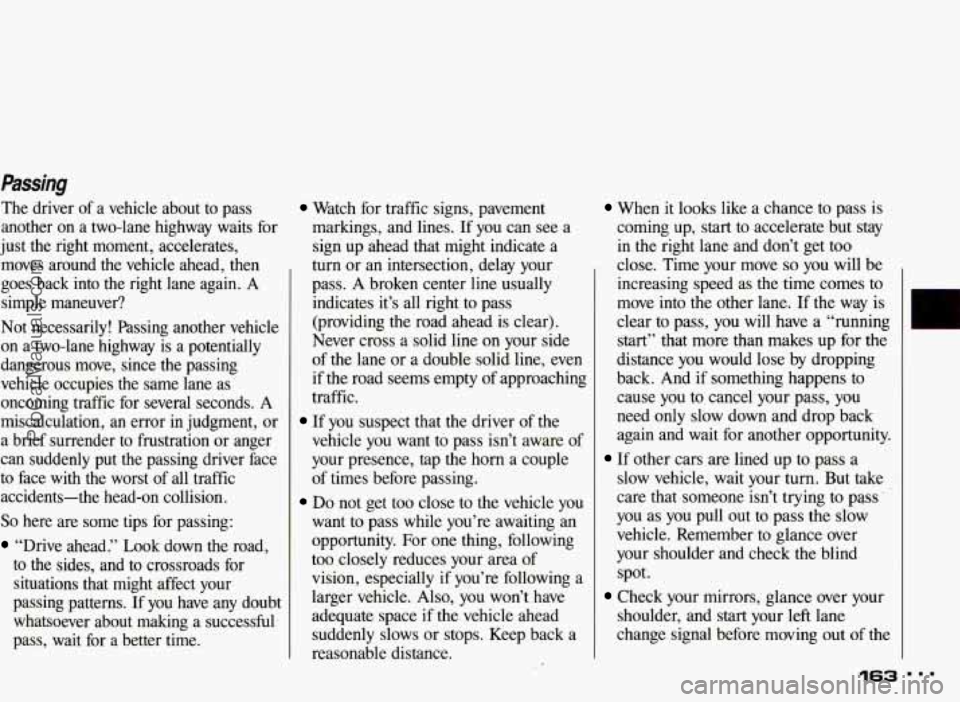
Passing
The driver of a vehicle about to pass
another on a two-lane highway waits for
just the right moment, accelerates,
moves around
the vehicle ahead, then
goes back into the right lane again.
A
simple maneuver?
Not necessarily! Passing another vehicle
on a two-lane highway is a potentially
dangerous move, since the passing
vehicle occupies the same lane as
oncoming traffic for several seconds.
A
miscalculation, an error in judgment, or
a brief surrender to frustration or anger
can suddenly put the passing driver face
to face with the worst of all traffic
accidents-the head-on collision.
So here are some tips for passing:
“Drive ahead.” Look down the road,
to the sides, and to crossroads for
situations that might affect your
passing patterns. If you have any doubt
whatsoever about making a successful.
pass, wait for a better time.
Watch for traffic signs, pavement
markings, and lines.
If you can see a
sign up ahead that might indicate a
turn or an intersection, delay your
pass. A broken center line usually
indicates it’s all right to pass
(providing the road ahead is clear).
Never cross a solid line
on your side
of the lane or a double solid line, even
if the road seems empty of approaching
traffic.
vehicle you want
to pass isn’t aware of
your presence, tap the horn a couple
of times before passing.
Do not get too close to the vehicle you
want to pass while you’re awaiting an
opportunity. For one thing, following
too closely reduces your area of
vision, especially if you’re following
a
larger vehicle. Also, you won’t have
adequate space
if the vehicle ahead
suddenly slows or stops. Keep back a
reasonable distance.
If you suspect that the driver of the
When it looks like a chance to pass is
coming up, start to accelerate but stay
in the right lane and don’t get too
close. Time your move
so you will be
increasing speed as the time comes to
move into the other lane. If the way is
clear to pass, you will have a “running
start’’ that more than makes up for the
distance you would lose by dropping
back. And if something happens to
cause you to cancel your pass,
you
need only slow down and drop back
again and wait for another opportunity.
slow vehicle, wait your turn. But take
care that someone isn’t trying to pqss
you as
you pull out to pass the slow
vehicle. Remember to glance over
your shoulder and check the blind
spot.
Check your mirrors, glance over your
shoulder, and start your left lane
change signal before moving out
of the
If other cars are lined up to pass a
L
163
ProCarManuals.com
Page 165 of 322
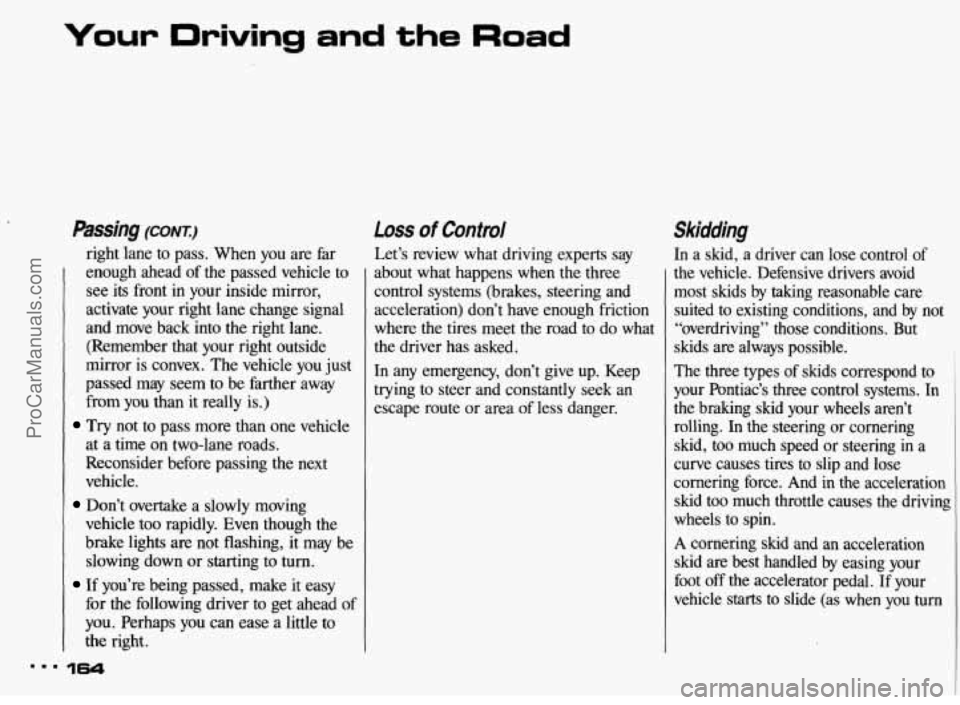
Your Driving and the Road
Passing (CONX:)
right lane to pass. When you are far
enough ahead of the passed vehicle to
see its front in your inside mirror,
activate your right lane change signal
and move back into the right lane.
(Remember that your right outside
mirror is convex. The vehicle you just
passed may seem to be farther away
from you than it really is.)
Try not to pass more than one vehicle
at a time on two-lane roads.
Reconsider before passing the next
vehicle.
vehicle too rapidly. Even though the
brake lights are not flashing,
it may be
slowing down or starting to
turn.
If you’re being passed, make it easy
for the following driver to get ahead
of
you. Perhaps you can ease a little to
the right.
Don’t overtake a slowly moving
Loss of Control
Let’s review what driving experts say
about what happens when the three
control systems (brakes, steering and
acceleration) don’t have enough friction
where the tires meet the road to do what
the driver has asked.
In any emergency, don’t give up. Keep
trying to steer and constantly seek
an
escape route or area of less danger.
Skidding
In a skid, a driver can lose control of
the vehicle. Defensive drivers avoid
most skids by taking reasonable care
suited to existing conditions, and by not
“overdriving” those conditions. But
skids are always possible.
The three types of skids correspond to
your Pontiac’s three control systems. In
the braking skid your wheels aren’t rolling. In the steering or cornering
skid, too much speed or steering in a
curve causes tires to slip and lose
cornering force. And in the acceleration
skid too much throttle causes the driving
wheels
to spin.
A cornering skid and an acceleration
skid are best handled by easing your
foot
off the accelerator pedal. If your
vehicle starts to slide (as when
you turn
ProCarManuals.com
Page 167 of 322
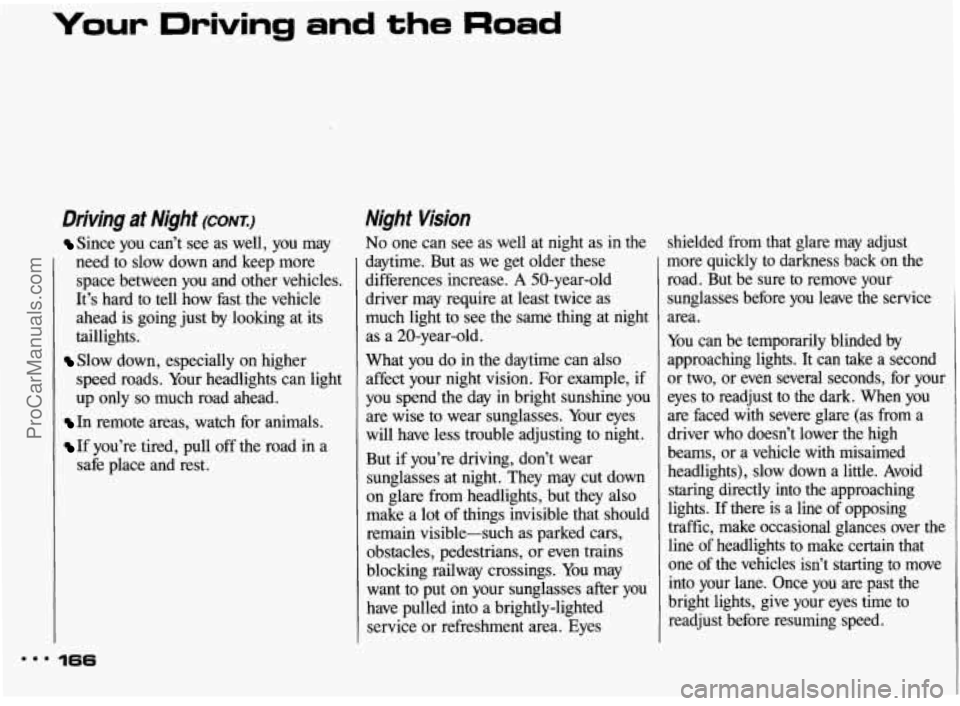
Your Driving and the Road
Driving at Night (CONT.:)
Since you can’t see as well, you may
need to slow down and keep more
space between you and other vehicles.
It’s hard
to tell how fast the vehicle
ahead is going just by looking at its
taillights.
Slow down, especially on higher
speed roads, Your headlights can light
up only
so much road ahead.
In remote areas, watch for animals.
If you’re tired, pull off the road in a
safe place and rest.
Night Hsion
No one can see as well at night as in the
daytime. But as we get older these
differences increase.
A 50-year-old
driver may require at least twice as
much light
to see the same thing at night
as a 20-year-old.
What you do in the daytime can also
affect your night vision. For example, if
you spend the day in bright sunshine you
are wise to wear sunglasses. Your eyes
will have less trouble adjusting to night.
But if you’re driving, don’t wear
sunglasses at night. They may cut down
on glare from headlights, but they also
make a lot of things invisible that should
remain visible-such as parked cars,
obstacles, pedestrians, or even trains
blocking railway crossings.
You may
want to put
on your sunglasses after you
have pulled into a brightly-lighted
service or refreshment area. Eyes shielded from that glare
may adjust
more quickly to darkness back
on the
road. But be sure to remove your
sunglasses before you leave the service
area.
You can be temporarily blinded by
approaching lights. It can take a second or two, or even several seconds, for your
eyes to readjust to the dark. When you
are faced with severe glare (as from a
driver who doesn’t lower the high
beams, or a vehicle with misaimed
headlights), slow down a little. Avoid
staring directly into the approaching
lights.
If there is a line of opposing
traffic, make occasional glances over the line
of headlights to make certain that
one of the vehicles isn’t starting to move
into your lane. Once you are past the
bright lights, give your eyes time to
readjust before resuming speed.
mmm 166
ProCarManuals.com